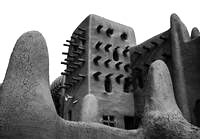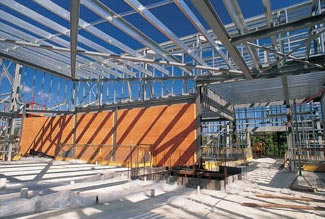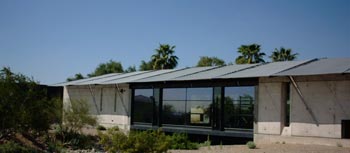
Brazilian photographer Jose Luis Berzal sends a link to a series of beautiful photos of adobe architecture from his recent trip to Mali.

Architecture, Art, Design, and Culture using of mud, clay, soil, dirt & dust.

Brazilian photographer Jose Luis Berzal sends a link to a series of beautiful photos of adobe architecture from his recent trip to Mali.
The Brazilian Association of Earth Builders – ABCTerra, established in 1997, is a non governmental organization whose goals are to disseminate, stimulate and promote the development of the architecture constructed of raw earth in Brazil.
Portugese language website. Translate at babelfish.

The book, Rural Studio: Samuel Mockbee and an Architecture of Decency documents several rammed earth structures designed and built by Auburn School of Architecture students in Hale County, Alabama.
The Ninth Conference on the Research and Protection of Unbaked Mud Monuments opened at Dowlatabad Garden and was attended by a number of world experts. Speaking at the inaugural ceremony, Head of Yazd province Cultural Heritage Department Seyed Mohammad Beheshti reiterated the importance of the unbaked mud monuments and the inherent complexities of the material.
For an increasing number of determined people, the Australian dream is not just owning your own home. It is building it. This seems especially true in Victoria, where one in five of the $7.9 billion worth of domestic building jobs is done by ownerbuilders. Many, such as Melbourne journalist, Murray Johnson, do not have any building experience, but manage to erect impressive homes. Johnson, 45, began his mud brick house when spiralling Melbourne house prices ruled him out of the market at the end of the 1990’s.

The National Wine Centre of Australia, located in Adelaide, South Austrailia, was designed by Grieve Gillette and Cox Architects. According to the builder, Mitchell Builders, it contains the largest rammed earth wall in Austrailia. Soil taken from all leading wine districts was used in the construction of the wall, which makes up the center spine of the building. The architecture emerges from this spine much like a grape vine from the soil. More construction photos of the Centre are available at the National Wine Centre website and more info and photos can be found at www.archidose.org
The LEHM 2004 is the 4th international conference and trade fair for building with earth and will be held at the famous Leipziger Messe in Leipzig, Germany, October 27-30th, 2004. The conference will coincide with the denkmal 2004, one of the largest trade fairs worldwide for reconstruction and conservation. The previous denkmal 2002 attracted more than 18,000 visitors from 35 countries with more than 400 exhibitors from 15 countries.
In Germany as in many other parts of the world, earth is used as a building material in conservation work. The LEHM 2004 conference will focus on “Earth in Building Conservation”. The Dachverband Lehm e.V. extends an open invitation to all interested professional colleagues to submit thematic relevant contributions and papers for the LEHM 2004 conference as well as for a poster session which will be exhibited parallel to the conference. The theme of the conference programme will include the following subject areas:
– Earthen building: a thousand years of building culture
– UNESCO world heritage – building with earth
– New earthen building technology in conservation practice
– New projects forum (as a permanent conference feature)
Candidates wishing to present a paper or poster at the conference are requested to submit a short overview (abstract) of not more than 500 words. Submissions can be in German or English. More details, submission information and deadlines are available from: www.dachverband-lehm.de/lehm2004

Butabu: Adobe Architecture of West Africa by architectural photographer James Morris and Professor of African Art and Architecture at Harvard University, Suzanne Preston Blier, shows the sublime sculptural beauty, variety, ingenuity, and originality of Sahalian Architecture in the West African countries of Mali, Niger, Nigeria, Togo, Benin, Ghana, and Burkina Faso where people have been constructing earthen buildings for centuries.

The House of Earth and Light, a private residence designed by Iraq-born, Phoenix Architect Marwan Al-Sayed uses a 3-layer fabric roof to bring tension and lightness to the thick poured gypsum walls. Computer renderings of the building show the proposed quality of the architecture. More information can be found here in an article by the Industrial Fabrics Association International (.pdf format).
The Handbook for Building Homes of Earth, published by the Peace Corps Information and Collection Exchange, is available on-line with chapters discussing adobe, rammed earth, compressed earth and other relevant technologies and methods.